After spending an exciting day yesterday in the Colca Canyon, we arrived late in the southern Peru city of Puno located over 600 miles south of Lima. Many people arrive in the city only to scram to find a trip to the nearby famous Lake Titicaca. But we had planned to spend a couple of days to see Peru's folklore capital as the region around Puno is one of the most culturally significant in the entire Andes. We needed to take it easy, though, as the altitude in Puno, at over 12,500 feet above sea level, was nothing to trifle with.
Once we heard the parade from our hotel room just a few steps away from the main square that was called of course, the Plaza de Armas like all other towns or cities in Peru, I could hardly wait to actually see it!
The focal point of the town square was the 17th century Spanish baroque-style cathedral.
One of the most eclectically carved facades of any church we'd seen was sculpted by Peruvian architect Simon de Asto.
Steven had gotten pretty sick from the high altitude on the long bus ride to Puno after catching sight of the magnificent condors, so he decided to return to the hotel and sleep and not join me seeing any more of the town's sights that morning and the Sillustani stone burial towers in the afternoon.
The Cathedral spire was just visible from one of the center's alleys.
The Inca Room showed many ceramics from pre-Inca and Inca periods from many different cultures.
What I liked seeing were the beautiful red textiles from Isla Taquile, one of the islands in Lake Titicaca.
The Pukara culture had a religion called Yaya Mama in which priests offered human heads to the deity.
This pretty oil was painted in 2009.
The Sillustani Room showcased a remarkable collection of 501 gold pieces discovered in 1971 when people found a stone tomb called 'Chullpa of the Lizard.' When the tomb was removed, mummies and the gold were discovered. From 300-900 AD, the Colla people dressed with gold hung in their clothes. It isn't known if they were warriors as some mummies were also found outside the tomb.
The Colonial Room showed the importance of the silver mines for the Spanish conquerors. The indigenous people were forced to work in the mines and make countless pieces of silver ornaments, jewelry and other items for the Spaniards.
The adorable image of the mermaid was refreshing.
This was one of the smallest images of Jesus on a cross I'd ever seen. I was unable to get the camera to focus on it for greater detail.
The museum's Religious Room exhibited immediately identifiable Cusco School-style paintings with gold detail from the 18th through 20th centuries.
I loved how attentive schoolchildren were being introduced to their homeland's culture in the museum's courtyard. The small Museo Municipal Carlos Dreyer was a delightful find and full of wonderful history, from archaeological finds to textiles.
I felt like I had stepped back in time when I eyed men typing on old fashioned typewriters on the street. I suspected they were typing legal documents because they were in front of a law office.
I hadn't heard the tell-tale ping of a typewriter's keys in years!
En route to the Iglesia San Juan Bautista, I encountered a huge long line of people that stretched around the corner waiting to enter a bank. Could it have been a run on the bank's deposits or why were there well over a hundred people there?
I could hear and then see another parade from an attractive pedestrian street before the church came into view.
This was obviously a religious procession.
I wish I had known why so many people in the parade were dressed in blue and had blue confetti in their hair.
I had to wait to enter the UNESCO-listed church until the parade had passed by.
The 18th century church had been entrusted with the care of the Virgin of Candlemas, the focus of Puno's most important yearly celebration in February, the Festival de la Virgen de la Candelaria.
The statue rested on the main altar.
Across from the church was Parque Pino, obviously a good spot to relax!
The monument in the center of the park was dedicated to Manuel Pino, a local doctor, educator and politician. He died in the battle of Miraflores which was part of the War of the Pacific (1879-1883).
I caught up with the religious parade again as I made my way back to the Plaza de Armas in the center of the city.
My last view of the parade participants was in front of the Palacio de Justicia before I returned to the hotel to check on Steven.
Once we heard the parade from our hotel room just a few steps away from the main square that was called of course, the Plaza de Armas like all other towns or cities in Peru, I could hardly wait to actually see it!
It was fun standing in the square and watching as the parade's participants wound their way around the entire square.
Spaniard Viceroy Conde de Lemos founded Puno in 1668, naming it San Carlos de Puno. I read that the town blends "the two ancient Andean civilizations of the Aymara from the south and the Quechua from the north with colonial influences.
The result is a rich diversity of high-spirited folk festivals, often hailed as the best in Peru. More than 300 dances have been cataloged in the region. Some satirize the Spanish, some celebrate Andean beliefs, while others are pure religious revelry."
After watching the parade, Steven and I dropped off ten kilos of dirty laundry at a local cleaners - that was the most amount of dirty clothes we'd ever had!
The focal point of the town square was the 17th century Spanish baroque-style cathedral.
One of the most eclectically carved facades of any church we'd seen was sculpted by Peruvian architect Simon de Asto.
The church was, by comparison, pretty plain on the inside.
Its main decoration was a silver-plated altar.Steven had gotten pretty sick from the high altitude on the long bus ride to Puno after catching sight of the magnificent condors, so he decided to return to the hotel and sleep and not join me seeing any more of the town's sights that morning and the Sillustani stone burial towers in the afternoon.
The 17th century colonial building La Casa del Corregidor, also on the Plaza de Armas, made me feel like I should have been in the Mediterranean with its vibrant colors. Now a cultural center, it was originally home to a Catholic priest who served as a corregidor - a Spanish official who acted as governor, judge and tax collector - and oversaw construction of the cathedral.
The vibrant cultural locale included an arts cooperative, a fair-trade cafe, library, and a few upscale handicraft shops.
I don't remember ever seeing all of a cactus's blooms flowering at once before.
The Cathedral spire was just visible from one of the center's alleys.
On the square's next corner was the Museo Carlos Dreyer named after a German illustrator and watchmaker born in 1895 who later moved to Peru where he lived for fifty years. It was his work as a connoisseur and collector of pre-Columbian objects and as a painter that helped make the small museum one of the most important regional archaeological museums in southern Peru.
Dreyer was the only Puno painter of his generation able to make a living as a painter. He painted landscapes of the altiplano - the high tableland of central South America - and portrayed common people's everyday life and scenes of customs and traditions.The Inca Room showed many ceramics from pre-Inca and Inca periods from many different cultures.
In the Stone Gallery Room there were stone pieces from the Pukara culture that developed near Puno. This anthropomorphic granite rock head was from 200 BC.
The Pukara people used large stones in tombs like headstones with animal figures, especially fishes and frogs.
This pretty oil was painted in 2009.
The Sillustani Room showcased a remarkable collection of 501 gold pieces discovered in 1971 when people found a stone tomb called 'Chullpa of the Lizard.' When the tomb was removed, mummies and the gold were discovered. From 300-900 AD, the Colla people dressed with gold hung in their clothes. It isn't known if they were warriors as some mummies were also found outside the tomb.
What a shame this photo doesn't show the brilliance of each of the gold pieces I remember so well.
The well preserved mummies found in Sillustani were one of the spookiest exhibits we'd ever seen.
Contemporary art works lined walls between the gallery's rooms.The adorable image of the mermaid was refreshing.
This was one of the smallest images of Jesus on a cross I'd ever seen. I was unable to get the camera to focus on it for greater detail.
The museum's Religious Room exhibited immediately identifiable Cusco School-style paintings with gold detail from the 18th through 20th centuries.
A Spanish soldier's helmet:
Side views of the town's remarkable cathedral:
I felt like I had stepped back in time when I eyed men typing on old fashioned typewriters on the street. I suspected they were typing legal documents because they were in front of a law office.
I hadn't heard the tell-tale ping of a typewriter's keys in years!
This intricately carved wooden balcony marked the home where Conde de Lemos stayed when he arrived in Puno in 1868 to restore order in a rebellion between mixed raced miners and white people in Laicacota.
Located behind the cathedral, the home was now the National Cultural Institute of Puno.
I could hear and then see another parade from an attractive pedestrian street before the church came into view.
This was obviously a religious procession.
I wish I had known why so many people in the parade were dressed in blue and had blue confetti in their hair.
I had to wait to enter the UNESCO-listed church until the parade had passed by.
The 18th century church had been entrusted with the care of the Virgin of Candlemas, the focus of Puno's most important yearly celebration in February, the Festival de la Virgen de la Candelaria.
The statue rested on the main altar.
Across from the church was Parque Pino, obviously a good spot to relax!
The monument in the center of the park was dedicated to Manuel Pino, a local doctor, educator and politician. He died in the battle of Miraflores which was part of the War of the Pacific (1879-1883).
It appeared more reading of the papers at the newspaper kiosk was being done rather than buying of the papers.
Back on the pedestrian mall, I noticed the designs on the street proclaiming Puno as Peru's folkloric capital.I caught up with the religious parade again as I made my way back to the Plaza de Armas in the center of the city.
My last view of the parade participants was in front of the Palacio de Justicia before I returned to the hotel to check on Steven.
Unfortunately, he was still feeling wretched so, as he preferred to be alone, I left shortly to join an afternoon tour we had booked to view the Sillustani funeral tombs.
Next post: The Sillustani funeral tombs.
Posted on February 15th, 2018, from Littleton, Colorado.





























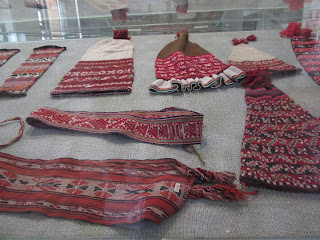











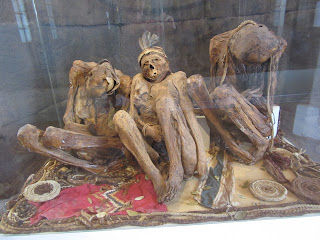









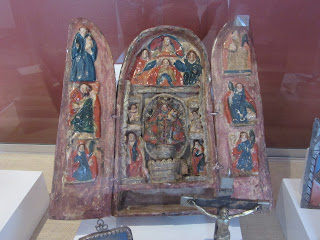







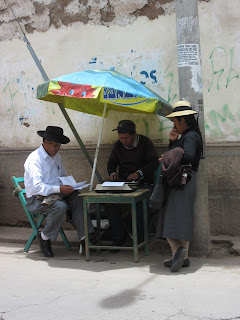









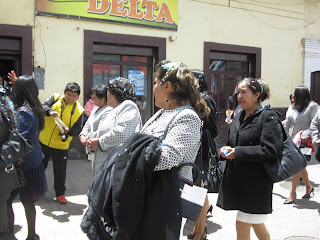


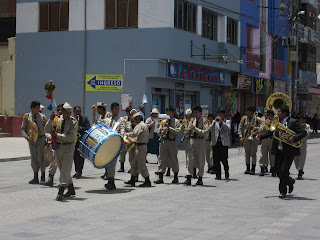





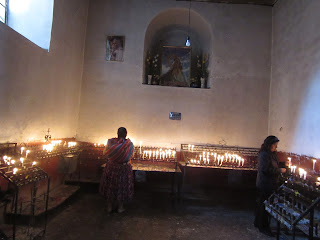










No comments:
Post a Comment